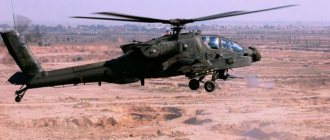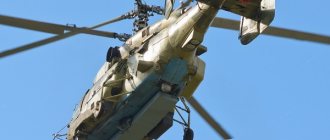In 2022, the ground forces, airborne forces and coastal forces will receive more than a thousand units of equipment. During a speech at an extended meeting of the board of the Ministry of Defense, the head of the defense department, Sergei Shoigu, noted that the military will receive launchers with intercontinental ballistic missiles (ICBMs), strategic missile carriers, new air defense systems and a nuclear submarine cruiser. In turn, 257 aircraft will be transferred to the Aerospace Forces. Some types of equipment and weapons will be supplied to the troops for the first time in 2022, and a number of promising developments will be closer to being put into service. About helicopters, rockets, airplanes and other new products - in the material of Lenta.ru.
Hypersonic anti-ship cruise missile "Zircon"
Serial deliveries of Zircon hypersonic missiles will begin in 2022
Frame: Press service of the Ministry of Defense of the Russian Federation
On December 24, Russian President Vladimir Putin announced the successful salvo launch of Zircon missiles. This event marked a milestone in the multi-year development and testing of the hypersonic missile. Shortly before this, Sergei Shoigu spoke about serial deliveries of the rocket in 2022.
As part of the tests, the missile was launched from the submarine Severodvinsk and from the frigate Admiral of the Fleet of the Soviet Union Gorshkov.
Strategic missile system RS-28 "Sarmat"
Tests of the Sarmat ballistic missile
Frame: Press service of the Ministry of Defense of the Russian Federation
At an extended meeting of the board of the Ministry of Defense, Sergei Shoigu announced that in 2022, the arsenal of the Strategic Missile Forces (RVSN) will be replenished with 21 launchers with intercontinental ballistic missiles (ICBMs). Speaking about new products, the Minister of Defense mentioned the Sarmat complex, which is being tested.
Earlier, the commander of the Strategic Missile Forces, Colonel General Sergei Karakaev, said that the first regiment armed with the Sarmat ICBM would go on combat duty in 2022. The Uzhur missile formation will receive new weapons.
It is believed that the RS-28 can deliver a warhead weighing up to 10 tons to anywhere in the world. The promising silo-based strategic missile system will replace the R-36M2 Voevoda missiles.
"Kurgans" and "Boomerangs".
0
The Ministry of Defense pays special attention to expanding the capabilities and functionality of motorized rifles, which is why modern infantry does not travel on foot. It is trained for highly maneuverable warfare, autonomous battles in isolated areas, and is taught stealth and rapid change of areas of operation, which is impossible to achieve without reliable transport. The Russian defense industry has developed the latest models of tracked and wheeled vehicles for the infantry, which will soon replace the well-deserved BMP-2 and BTR-80 currently in service. On the basis of the Kurganets-25 universal tracked platform, it is planned to create an infantry fighting vehicle, an airborne combat vehicle, a tracked armored personnel carrier and an anti-tank self-propelled gun with a 125 mm tank gun. New vehicles are capable of delivering fighters to the desired point on the battlefield, providing cover and supporting them with heavy cannon and machine gun fire.
0
The signature features of the Kurganets-25-based infantry fighting vehicle are a high level of robotization and ammunition and weapons isolated from people. The firepower is impressive - the Epoch remote-controlled combat module includes a 30-mm 2A42 automatic cannon with 500 rounds of ammunition, a 7.62-mm PKTM machine gun with a 2,000-round belt, and two dual launchers for the Kornet anti-tank system. The robotic “Epoch” can itself track the target and fire at it until it is completely destroyed - the operator just needs to point at the object.
0
The promising wheeled armored personnel carrier on the unified Boomerang platform will be armed with the Tula-made Boomerang-BM combat module, equipped with a 30-mm cannon with 500 rounds of ammunition and a firing range of up to four kilometers, a machine gun, an automatic grenade launcher and Kornet missiles. It is important that the Boomerang’s engine is located in the front part, so troops can land and disembark from the stern. Thus, when leaving the vehicle in battle, infantrymen immediately find themselves covered from enemy fire by its body. On the basis of this platform, in the future, a wheeled infantry fighting vehicle, a combat vehicle with heavy weapons, and other types of equipment that will go to medium brigades of the Ground Forces can also be created.
Anti-aircraft missile system "Gibka-S"
Anti-aircraft missile system "Gibka-S"
Photo: JSC NPO High-Precision Complexes
In 2022, air defense units will receive platoon sets of Gibka-S anti-aircraft missile systems (SAM) for the first time. The head of the military air defense of the Russian Armed Forces, Lieutenant General Alexander Leonov, noted that the new air defense system received reconnaissance equipment and an automatic control system. This allows the military to maintain round-the-clock watch and control fire in real time.
Also, Gibka-S became the first Russian self-propelled short- and ultra-short-range complex of the VSHORAD (Very Short-Range Air Defense) type. The air defense system can hit airplanes, helicopters, drones and cruise missiles that fly at a minimum altitude. "Gibka-S" uses ammunition from man-portable anti-aircraft missile systems (MANPADS) "Igla", "Igla-S" and "Verba".
Russian nuclear weapons
Nuclear weapons have been adopted since the times of the USSR. This is a whole complex that includes ammunition itself, carriers and means of transportation, as well as control systems. The action of the weapon is based on nuclear energy, which is released during the fission or fusion reaction of nuclei.
Russia's new nuclear weapon today is the RS-24 Yars. Development on it began under the USSR in 1989. After Ukraine refused to develop it jointly with Russia, all design developments were transferred to MIT in 1992. The design of the Yars rocket is similar to the Topol-M. Its difference is a new platform for breeding blocks. The Yars has an increased payload, and the hull is treated with a special compound to reduce the impact of a nuclear explosion. This missile is capable of performing programmed maneuvers and is equipped with a complex to counter missile defense systems.
Ka-52M reconnaissance and attack helicopter
Photo: Konstantin Mikhalchevsky / RIA Novosti
During the international military-technical forum Army 2021, which was held in August, the Ministry of Defense and the Russian Helicopters holding company signed a contract for the supply of modernized Ka-52M helicopters. As part of the agreement, the military will receive 30 reconnaissance and attack vehicles. Later, a source in the aircraft industry said that helicopter deliveries would begin in 2022.
The Ka-52M received a modernized optical-electronic system and a new radar complex with an active phased array antenna (AFAR). Also, the modernized helicopter will be able to carry new weapons, including Ataka, Vikhr and Vikhr-M missiles.
With an eye on the future
“Modern Russia cannot repeat the successes of the Soviet Union in the field of creating new types of weapons,” is often heard from the lips of skeptical foreign “experts” who are unable to support their own statements with any significant arguments. However, domestic designers do not pay attention to such “authoritative opinions”. Their priority is to provide the country's army with the best weapons, the best aviation, and the best land and sea equipment.
Among the main achievements of the state’s military-industrial complex in 2022, the new products that were shown to the general public for the first time, which caused a storm of discussion not only in Russia, but also in the West, especially stand out. We are talking about a promising fifth-generation fighter, an anti-aircraft missile system of the future, a high-precision means of combating enemy tanks and weapons for pilots.
"Checkmate"
The leader of the competition for the title of the loudest premiere of the year is considered to be the newest creation of domestic aircraft designers - the light tactical aircraft Su-75 Checkmate. The aircraft was first shown at the International Aviation and Space Salon MAKS-2021, where it created a real sensation.
Global Look Press / Leonid Faerberg/Keystone Press Agency
To truly understand the significance of this event in the history of Russian aviation, it is necessary to remember that the new “drying” was the first single-engine fighter in the last half century, created both for the needs of its own aerospace forces and for export to friendly countries.
A special feature of the Su-75 was the modified concept caused by the updated approach to the vision of a highly efficient “echeloned” composition of the country’s aircraft fleet. Thus, in addition to the heavy twin-engine multipurpose Su-57, it was decided to add a light companion, leveling out the difference in combat effectiveness with mass production.
The result of many years of painstaking work was “Checkmate”, largely unified with the PAK FA. We are talking not only about avionics and the range of weapons, but also about the power plant of the second stage “Product 30”, which completes the cycle of state tests.
wikipedia.org/Doomych
Despite the fact that most of the characteristics of the development are kept secret, it is already obvious that foreign analogues of the machine will not like meeting the Su-75 in the sky. Especially given that the developer has already announced the construction of an unmanned version of the aircraft.
On guard of space
No sooner had the newest anti-aircraft missile system S-500 “Prometheus” taken its place in the troops, replacing the S-300 and S-400 systems, than a new development, designated S-550, is already being prepared to replace it. It was first announced by Russian Defense Minister Sergei Shoigu at the beginning of November 2021, speaking at a conference call.
https://t.me/rian_ru/129144
The head of the Ministry of Defense did not provide any information about the new air defense system. Only one thing is known - the system will be aimed at combating ballistic and hypersonic glide missiles in near space. The decision to significantly push back the edge of missile defense was made on the basis of increased activity by foreign scientists to create weapons that fly in areas of space inaccessible to missile defense systems. China has achieved particular success in this direction, having tested a hypersonic space glider in August.
According to some experts, it was the S-550 that was used in mid-November while performing a training mission to eliminate an outdated artificial satellite. The test launch was reported by the country's defense department.
“In particular, on November 15, the Russian Ministry of Defense successfully carried out a test, as a result of which the inactive Russian Tselina-D spacecraft, which had been in orbit since 1982, was destroyed,” the statement said.
What the final appearance of the S-550 will be is unknown. However, it can be stated with certainty that such work ahead of domestic designers will make future Western developments in the field of intercontinental missiles obsolete even before they are born.
To replace "Attack"
The first premiere of the newest light multi-purpose guided missile, designated “Product 305”, within the framework of the international military-technical forum “Army-2021” was also very long-awaited. The device is intended for use on combat helicopters such as Mi-8, Mi-24, Mi-28 “Night Hunter” and Ka-52 “Alligator”. The task of the LMUR is to combat any enemy ground targets.
PolitRussia / German Parlo
It would seem that the 9M120 “Attack”, which is now part of the arsenal of domestic rotary-wing aircraft, has exactly the same range of tasks. The question arises, what is the practical novelty of Product 305 and the significance of this development for the country’s army?
The thing is that Product 305, unlike its predecessor, has a combined control system through not only an active homing head, but also flight correction systems based on satellite reconnaissance data and operator commands. All of the above minimizes the chance of a miss in the event of an attack on a point target significantly removed from the launch point.
The combat characteristics of the new missile are also outstanding. Thus, its maximum firing range is almost 15 km. For comparison: “Attack” is capable of attacking targets no more than 6 km away. The famous AGM-114 Hellfire ATGM, which is the main guided weapon of the American attack helicopters AH-1 Cobra, AH-64 Apache and MQ-1 Predator, MQ-9 Reaper drones, is limited to only 10 km of flight. At the same time, the mass of the Hellfire's cumulative warhead is 8 kg, while the high-explosive fragmentation warhead of the Product 30 holds 25 kg of explosive.
For emergency situations
Another new product shown during Army 2021 was the 9-mm PPK-20 submachine gun from the Kalashnikov concern, intended for arming tactical special forces units and combat aviation pilots. Thanks to its compact dimensions, integrated silent firing device, active use of polymer elements and changes in controls, the model is ideally suited to the specifics of combat in confined spaces, and also does not take up much space in the cockpit of aircraft.
politexpert.net / Ilya Pushkarev
The basis for the creation of PPK-20 was the PP-19 Vityaz. At the same time, it is incorrect to consider the first as a deep modification of the second. In addition to external changes, for example, an abundance of Picatinny rails on the receiver, forend and gas trim, a plastic anatomical handle and trigger guard, a reversible diopter rear sight and a quick-release compact PBS, the new product received updates to its internal components.
For example, the firing mechanism and the fire switch have undergone significant changes. The latter is now a flag type and is located on both sides of the receiver. As a result, the PPK-20 can be used equally comfortably by both right- and left-handed people.
politexpert.net / Ilya Pushkarev
Of course, the presented new products play a big role in shaping the idea of the future of the Russian army. However, before entering service they still have to go through years of modifications and severe government tests. However, the troops were not left without “gifts” in 2022.
Loitering ammunition KUB-BLA
Loitering ammunition KUB-BLA
Personnel: JSC Concern Kalashnikov
In 2022, the Russian military will receive a new type of weapon. On December 17, the press service of the ZALA Aero company (part of the group) announced the successful completion of state tests of the KUB-BLA drone. The device was recommended for adoption, and deliveries could begin in 2022.
KUB-UAV received an electric motor, which provides a maximum speed of up to 130 kilometers per hour. The ammunition can stay in the air for up to 30 minutes, and the mass of the warhead is 3 kilograms.
Robotic complex "Uran-9"
Robotic complex "Uran-9"
Photo: Press service of the Russian Ministry of Defense
Also, 2022 will be another step in the full operation of robotic systems. In October, Commander-in-Chief of the Ground Forces, Army General Oleg Salyukov, announced that trial military operation of Uran-9 combat robots was planned for 2022. After this stage, the military will determine the number of robotic systems to be purchased.
In 2022, Uran-9 was successfully used at the joint strategic exercises between Russia and Belarus “Zapad-2021”. The robots successfully hit armored vehicles of a mock enemy at a distance of up to five thousand meters.
Automatic transformers.
0
The list of main contenders for the role of individual small arms of the Russian infantry now includes the Kalashnikov AK-12 and AK-15 calibers of 5.45 and 7.62 millimeters, respectively, and the AEK-971 produced by the Degtyarev plant, which can be produced in two calibers. One of them will be selected as a standard weapon for the Ratnik kit. All three machines are good in their own way and surpass the previous series in many respects. In particular, they have not two, but three firing modes: single, burst and short burst with a cut-off of three shots. Military tests of the newest AK-12 and AK-15 were successfully completed this summer. As RIA Novosti was told in the Rostec state corporation, promising machines have inherited from their eminent predecessors, perhaps, the main quality - reliability, while acquiring many other advantages. The designers achieved higher accuracy of fire, improved ergonomics due to a comfortable handle and an adjustable butt, and provided the ability to quickly and conveniently install day and night sights.
0
Thanks to the built-in Picatinny rails, the new Kalashnikov assault rifles have actually turned into transformers - you can instantly install a front grip, an under-barrel flashlight, a laser designator and other accessories on them. In addition, even in the basic version it is possible to quickly install all kinds of muzzle devices, including silencers. “We have developed a day-night sighting system for the Ratnik, which includes a collimator sight, a night vision monocular and a three-fold magnifying tube,” Nikolai Klimkin, general director of the optical-mechanical department, told RIA Novosti. “The fighter doesn’t have to take aim, align the front sight with the rear sight, but simply point the red dot at the target and press the trigger. This is very important in combat, especially in situations where there is no time to aim: an object moves quickly or appears in the field of view and immediately disappears.” Klimkin noted that the fundamental difference between Russian sighting systems and foreign ones is that they are mainly intended for urban police operations and are poorly suited for battle “in the field.” This is due to the radius of use - for Western sights it does not exceed 100 meters. The Russian complex is convenient in that the magnifying tube and night vision monocular can be removed from the weapon, mounted on a helmet and used for observation. In addition, “Jupiter” is now, on instructions from the Ministry of Defense, working on various ways to transmit information to a fighter about the target and the surrounding situation.
Fifth generation fighter Su-57
In 2022, troops of the Eastern Military District will receive the first Su-57 fighters
Photo: Anna Zvereva / Flickr
In 2022, the first multirole fighters of the fifth generation Su-57 will be received by the troops of the Eastern Military District (VVO). The commander of the Eastern Military District, Colonel General Alexander Chaiko, announced this during the final board meeting of the Russian Ministry of Defense.
The fifth generation fighter Su-57 is designed to destroy all types of ground, air and surface targets. The aircraft received a radio-absorbing coating and weapon compartments inside the fuselage, which makes the Su-57 stealth. The first production aircraft was handed over to the Russian Aerospace Forces in December 2022.
Where are different types of missiles used?
Missile weapons of warfare are designed to use:
- in underwater, air and space environments;
- for various targets - ground, surface, buried, underwater, air;
- at tactical (up to 300 km), operational-tactical (300-1000 km), medium (1001-5500 km) and long (over 5500 km) range.
The most striking example of the use of missiles in real combat conditions by Russian military personnel is the Russian military operation in Syria, including the launching of missile strikes by an aviation group of the Russian Aerospace Forces against targets of anti-government forces.
Source: razvedka_russia
Strategic bomber-missile carrier Tu-160M
In 2022, the new Tu-160M strategic bomber-missile carrier will fly
Photo: Photo: Rostec
The basic Tu-160 made its first flight in 1981, and in 2018, the Kazan Aviation Plant began production of modernized, newly built Tu-160M. In December, Deputy Prime Minister Yuri Borisov announced that a new Tu-160M flight was planned for 2022. The aircraft is being built on a new element base.
The Tu-160 remains the largest supersonic aircraft in aviation history. Also, the Tu-160 remains the heaviest combat aircraft and the fastest bomber. The Tu-160 is designed to destroy targets in remote areas with conventional and nuclear weapons.











